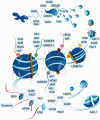EpiFactors: a comprehensive database of human epigenetic factors and complexes - PubMed (original) (raw)
EpiFactors: a comprehensive database of human epigenetic factors and complexes
Yulia A Medvedeva et al. Database (Oxford). 2015.
Abstract
Epigenetics refers to stable and long-term alterations of cellular traits that are not caused by changes in the DNA sequence per se. Rather, covalent modifications of DNA and histones affect gene expression and genome stability via proteins that recognize and act upon such modifications. Many enzymes that catalyse epigenetic modifications or are critical for enzymatic complexes have been discovered, and this is encouraging investigators to study the role of these proteins in diverse normal and pathological processes. Rapidly growing knowledge in the area has resulted in the need for a resource that compiles, organizes and presents curated information to the researchers in an easily accessible and user-friendly form. Here we present EpiFactors, a manually curated database providing information about epigenetic regulators, their complexes, targets and products. EpiFactors contains information on 815 proteins, including 95 histones and protamines. For 789 of these genes, we include expressions values across several samples, in particular a collection of 458 human primary cell samples (for approximately 200 cell types, in many cases from three individual donors), covering most mammalian cell steady states, 255 different cancer cell lines (representing approximately 150 cancer subtypes) and 134 human postmortem tissues. Expression values were obtained by the FANTOM5 consortium using Cap Analysis of Gene Expression technique. EpiFactors also contains information on 69 protein complexes that are involved in epigenetic regulation. The resource is practical for a wide range of users, including biologists, pharmacologists and clinicians.
© The Author(s) 2015. Published by Oxford University Press.
Figures
Figure 1.
Interactive navigation figure for web page. Names of the histones and complexes are linked to the corresponding entities of the database. Since complexes are represented by a group name, all complexes of the group will be shown when the complex name is clicked on the website navigation figure. Complexes are located in the area corresponding to the shown function. For example CAF-1 (in lower right corner) participates in nucleosome assembly after replication.
Figure 2.
The most frequently occurring Pfam domains in EpiFactors. Multiple occurrences of a domain within the same protein are counted as one occurrence.
Similar articles
- EpiFactors 2022: expansion and enhancement of a curated database of human epigenetic factors and complexes.
Marakulina D, Vorontsov IE, Kulakovskiy IV, Lennartsson A, Drabløs F, Medvedeva YA. Marakulina D, et al. Nucleic Acids Res. 2023 Jan 6;51(D1):D564-D570. doi: 10.1093/nar/gkac989. Nucleic Acids Res. 2023. PMID: 36350659 Free PMC article. - MetaImprint: an information repository of mammalian imprinted genes.
Wei Y, Su J, Liu H, Lv J, Wang F, Yan H, Wen Y, Liu H, Wu Q, Zhang Y. Wei Y, et al. Development. 2014 Jun;141(12):2516-23. doi: 10.1242/dev.105320. Epub 2014 May 21. Development. 2014. PMID: 24850854 - The role dietary of bioactive compounds on the regulation of histone acetylases and deacetylases: a review.
Vahid F, Zand H, Nosrat-Mirshekarlou E, Najafi R, Hekmatdoost A. Vahid F, et al. Gene. 2015 May 10;562(1):8-15. doi: 10.1016/j.gene.2015.02.045. Epub 2015 Feb 19. Gene. 2015. PMID: 25701602 Review. - Aberrant epigenetic landscape in cancer: how cellular identity goes awry.
Berdasco M, Esteller M. Berdasco M, et al. Dev Cell. 2010 Nov 16;19(5):698-711. doi: 10.1016/j.devcel.2010.10.005. Dev Cell. 2010. PMID: 21074720 Review. - Epigenetics primer: why the clinician should care about epigenetics.
Duarte JD. Duarte JD. Pharmacotherapy. 2013 Dec;33(12):1362-8. doi: 10.1002/phar.1325. Epub 2013 Jul 17. Pharmacotherapy. 2013. PMID: 23864439 Review.
Cited by
- Development of compact transcriptional effectors using high-throughput measurements in diverse contexts.
Tycko J, Van MV, Aradhana, DelRosso N, Ye H, Yao D, Valbuena R, Vaughan-Jackson A, Xu X, Ludwig C, Spees K, Liu K, Gu M, Khare V, Mukund AX, Suzuki PH, Arana S, Zhang C, Du PP, Ornstein TS, Hess GT, Kamber RA, Qi LS, Khalil AS, Bintu L, Bassik MC. Tycko J, et al. Nat Biotechnol. 2024 Nov 1. doi: 10.1038/s41587-024-02442-6. Online ahead of print. Nat Biotechnol. 2024. PMID: 39487265 - Temporal and Spatial Signatures of Scylla paramamosain Transcriptome Reveal Mechanistic Insights into Endogenous Ovarian Maturation under Risk of Starvation.
Fu Y, Zhang F, Wang W, Xu J, Zhao M, Ma C, Cheng Y, Chen W, Su Z, Lv X, Liu Z, Ma K, Ma L. Fu Y, et al. Int J Mol Sci. 2024 Jan 5;25(2):700. doi: 10.3390/ijms25020700. Int J Mol Sci. 2024. PMID: 38255774 Free PMC article. - A CIC-related-epigenetic factors-based model associated with prediction, the tumor microenvironment and drug sensitivity in osteosarcoma.
Yu B, Geng C, Wu Z, Zhang Z, Zhang A, Yang Z, Huang J, Xiong Y, Yang H, Chen Z. Yu B, et al. Sci Rep. 2024 Jan 15;14(1):1308. doi: 10.1038/s41598-023-49770-2. Sci Rep. 2024. PMID: 38225273 Free PMC article. - Comprehensive characterization of the embryonic factor LEUTX.
Gawriyski L, Jouhilahti EM, Yoshihara M, Fei L, Weltner J, Airenne TT, Trokovic R, Bhagat S, Tervaniemi MH, Murakawa Y, Salokas K, Liu X, Miettinen S, Bürglin TR, Sahu B, Otonkoski T, Johnson MS, Katayama S, Varjosalo M, Kere J. Gawriyski L, et al. iScience. 2023 Feb 9;26(3):106172. doi: 10.1016/j.isci.2023.106172. eCollection 2023 Mar 17. iScience. 2023. PMID: 36876139 Free PMC article. - Coexpression patterns define epigenetic regulators associated with neurological dysfunction.
Boukas L, Havrilla JM, Hickey PF, Quinlan AR, Bjornsson HT, Hansen KD. Boukas L, et al. Genome Res. 2019 Apr;29(4):532-542. doi: 10.1101/gr.239442.118. Epub 2019 Mar 11. Genome Res. 2019. PMID: 30858344 Free PMC article.
References
- Jaenisch R., Bird A. (2003) Epigenetic regulation of gene expression: how the genome integrates intrinsic and environmental signals. Nat. Genet., 33 Suppl, 245–254. - PubMed
- Tomazou E.M., Meissner A. (2010) Epigenetic regulation of pluripotency. Adv. Exp. Med. Biol., 695, 26–40. - PubMed
- Miller C.A., Sweatt J.D. (2007) Covalent modification of DNA regulates memory formation. Neuron, 53, 857–869. - PubMed
Publication types
MeSH terms
Substances
LinkOut - more resources
Full Text Sources
Other Literature Sources
Miscellaneous

